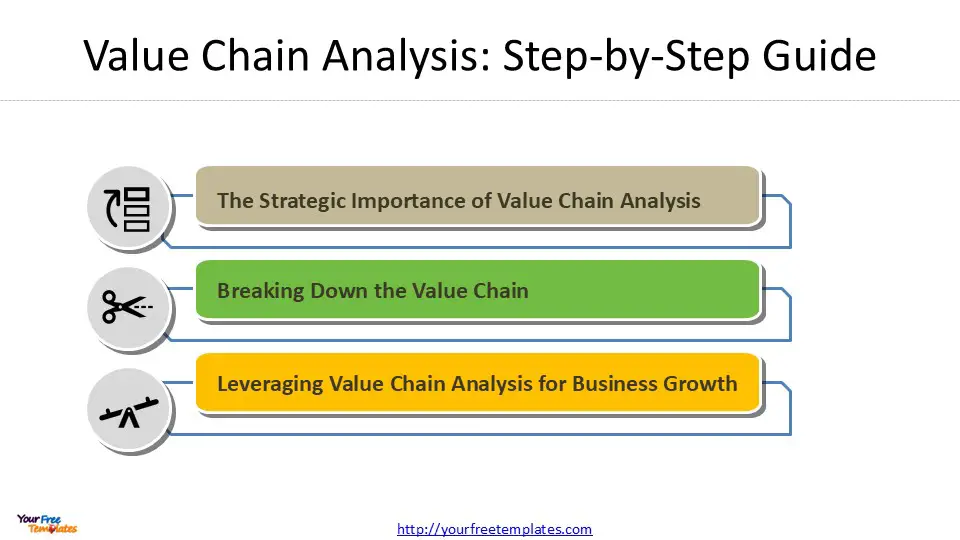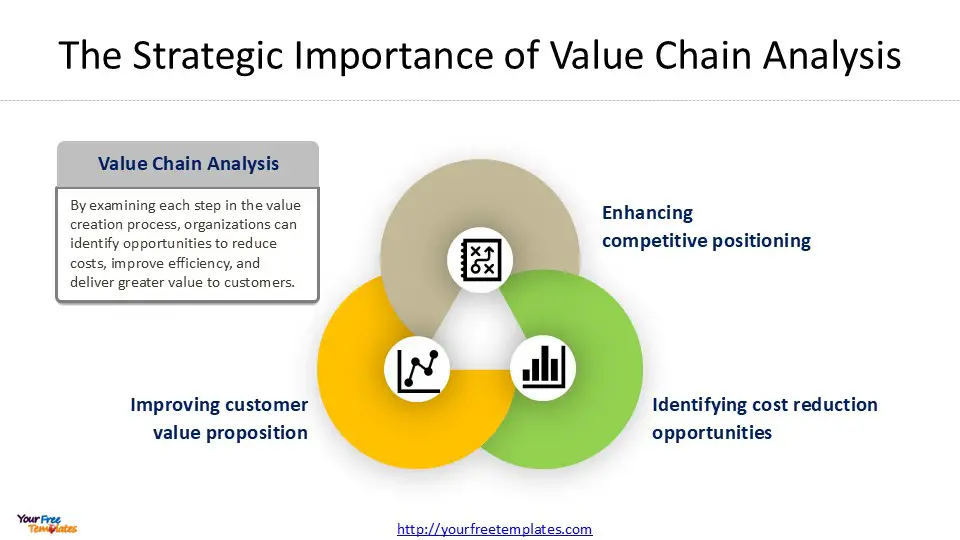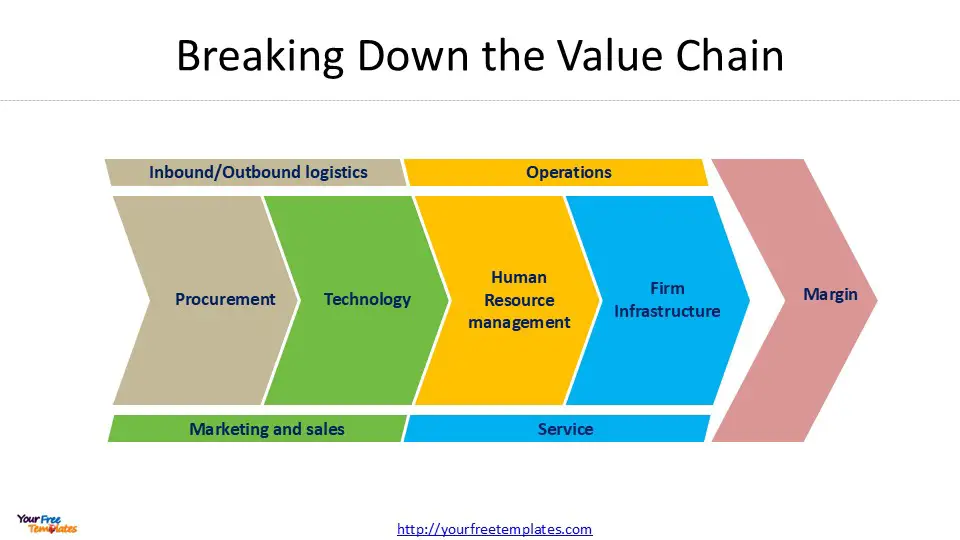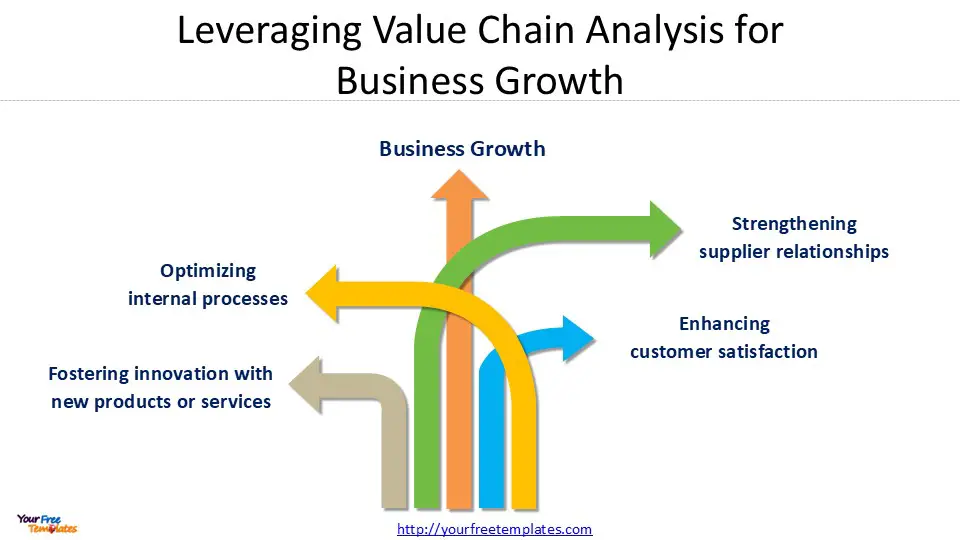Value chain analysis is a powerful tool that helps businesses understand how they create value for customers. It breaks down a company’s activities into distinct steps, showing where value is added and where improvements can be made. This strategic approach allows organizations to identify competitive advantages and enhance their overall performance.
At the end of this post, you can download our Value Chain Analysis PowerPoint template to fit your purpose. As the same diagram PowerPoint template series, you can also find our Climate Change, Carbon Neutral Meaning, Renewable Energy Sources, Generative AI, Circular Economy, Blue Sea Strategy, 2025 Calendar with Holidays, The 7 Habits of Highly Effective People, Six Thinking Hats, Pareto Chart, Occam’s Razor, Data Mining, marketing segment, Porter’s five forces, SWOT Analysis, GE Matrix, BCG Matrix, Artificial Intelligence, National Diamond and BlockChain PowerPoint templates.
In this guide, we’ll explore the key components of value chain analysis and how to conduct one effectively. We’ll discuss Porter’s value chain model, common value chain activities, and provide examples of successful value chain management. By the end, readers will have a clear understanding of how to leverage value chain analysis to drive business growth and increase profitability.

The Strategic Importance of Value Chain Analysis
Value chain analysis has emerged as a powerful strategic tool for businesses seeking to enhance their competitive positioning and drive growth. This analytical approach, introduced by Michael Porter, allows companies to break down their operations into strategically relevant activities, focusing on sources of competitive advantage 1. By examining each step in the value creation process, organizations can identify opportunities to reduce costs, improve efficiency, and deliver greater value to customers.
Enhancing competitive positioning
One of the primary benefits of value chain analysis is its ability to help companies strengthen their competitive position in the market. By dissecting the various activities that contribute to the creation and delivery of a product or service, businesses can pinpoint areas where they excel and areas that need improvement. This comprehensive view of operations enables managers to make informed decisions about resource allocation and strategic priorities.
Value chain analysis encourages companies to view each activity not just as a cost, but as a step that adds value to the final product or service 1. This perspective shifts the focus from mere cost-cutting to value creation, allowing businesses to differentiate themselves from competitors. By optimizing both primary and support activities, organizations can capture sustainable savings that enhance their bottom line and operational efficiency 2.
Identifying cost reduction opportunities
A crucial aspect of value chain analysis is its potential to uncover cost reduction opportunities across the entire organization. This approach goes beyond simple budget cuts, focusing instead on identifying inefficiencies and redundancies within the chain. By restructuring procurement processes, optimizing production workflows, and streamlining support activities like IT and HR, companies can achieve long-term savings without compromising operational quality 2.
For instance, extending strategic sourcing practices to complex categories can reduce spending by 5–25%, depending on the complexity and nature of the contracts involved 2. Similarly, optimizing the IT landscape through data center consolidation, vendor contract renegotiation, and elimination of redundant software licenses can drive substantial savings 2.
Improving customer value proposition
Perhaps the most significant impact of value chain analysis is its ability to enhance a company’s customer value proposition. By gaining a deeper understanding of customer needs and pain points, businesses can refine their products, services, and overall customer experience. This customer-centric approach has the potential to lead to better decisions and lasting advantages that benefit business activities for years to come 3.
A well-executed value chain analysis allows companies to align their operations with customer needs, ensuring that every step adds to the overall customer experience and improves satisfaction and loyalty 4. This alignment has a direct impact on a company’s ability to differentiate itself in the market and create a compelling value proposition that resonates with customers.
In conclusion, value chain analysis serves as a strategic framework that enables businesses to optimize their operations, reduce costs, and enhance their competitive position. By providing a structured approach to evaluating business processes, it helps companies identify unique value-creating activities that set them apart from competitors 4. As organizations continue to navigate an increasingly complex and competitive business landscape, the insights gained from value chain analysis will prove invaluable in driving sustainable growth and maintaining a competitive edge.

Breaking Down the Value Chain
Value chain analysis involves examining the various activities that contribute to a company’s competitive advantage. By breaking down the value chain into its primary components, businesses can identify areas for improvement and optimize their operations. Let’s explore the key elements of the value chain, focusing on inbound and outbound logistics, operations and production processes, and marketing, sales, and service activities.
Inbound and outbound logistics
Inbound logistics encompasses the processes related to receiving, storing, and managing raw materials and components needed for production. This crucial aspect of the value chain involves activities such as sourcing, purchasing, transportation, and storage of inputs. Effective inbound logistics management ensures that a company has the necessary resources to operate efficiently and meet customer demand.
For example, in the furniture manufacturing industry, inbound logistics would involve managing the arrival of raw materials like wood, paint, nuts, screws, and bolts. On the other hand, for an e-commerce company like Amazon, inbound logistics would focus on receiving, quality checking, and storing finished goods at their fulfillment centers.
Outbound logistics, conversely, deals with the movement of finished products from a company’s production facilities or warehouses to customers. This includes activities such as order processing, warehousing, transportation, and distribution. Efficient outbound logistics is essential for ensuring timely delivery of products and maintaining customer satisfaction.
In the case of a furniture manufacturer, outbound logistics would involve managing the delivery of finished furniture items like sofa sets, beds, and chairs to retailers. For furniture retailers, it would encompass the distribution of these products to end consumers in a timely and satisfactory manner.
Operations and production processes
Operations form the core of the value chain, involving the transformation of inputs into finished products or services. This stage focuses on optimizing production processes to enhance efficiency and quality while minimizing costs. Companies can gain a competitive edge by streamlining their operations and implementing innovative production techniques.
For instance, in the manufacturing sector, operations would include activities such as assembly, quality control, and packaging. In the service industry, operations might involve the delivery of services to customers, such as consultations or treatments in healthcare settings.
To optimize operations, companies often implement advanced planning and scheduling systems. These systems help track the movement of goods and anticipate demand, reducing delays and improving overall production efficiency. Additionally, leveraging technology such as automation and robotics can significantly enhance operational performance and reduce costs.
Marketing, sales, and service activities
Marketing and sales activities play a crucial role in creating demand for a company’s products or services and facilitating their purchase. This includes strategies to enhance visibility, target appropriate customers, and communicate the value proposition effectively. Activities in this category may include advertising, promotion, pricing strategies, and channel selection.
For example, an e-commerce company might run targeted ads on social media platforms or build an email list for email marketing campaigns to reach potential customers. Effective marketing and sales efforts can help companies differentiate themselves from competitors and build strong brand recognition.
Service activities, which take place after the sale, are essential for maintaining product effectiveness and enhancing the consumer experience. This includes customer service, maintenance, repair, refunds, and exchanges. In the e-commerce industry, for instance, service activities might involve offering repairs, replacements, or warranties for purchased products.
By focusing on these key components of the value chain, companies can identify opportunities to add value, reduce costs, and improve overall performance. Value chain analysis provides insights into how each activity contributes to the final product or service, enabling businesses to make informed decisions about resource allocation and strategic priorities. Through continuous improvement and optimization of these value chain activities, organizations can enhance their competitive position and drive sustainable growth in the market.

Leveraging Value Chain Analysis for Business Growth
Value chain analysis serves as a powerful tool for businesses to optimize their operations and drive growth. By examining each step in the value creation process, companies can identify opportunities to enhance efficiency, reduce costs, and deliver greater value to customers. This strategic approach allows organizations to gain a competitive edge in the market and improve their overall performance.
Optimizing internal processes
One of the primary benefits of value chain analysis is its ability to help companies streamline their internal processes. By breaking down each activity within the value chain, businesses can identify inefficiencies and redundancies that may be hindering their performance. This analysis enables organizations to make informed decisions about resource allocation and strategic priorities, ultimately leading to improved productivity and cost savings.
For instance, companies can use value chain analysis to optimize their operations and production processes. By examining each step in the manufacturing process, businesses can identify bottlenecks, reduce waste, and implement more efficient techniques. This optimization can lead to significant cost reductions and improved product quality, enhancing the overall customer experience.
Strengthening supplier relationships
Value chain analysis also provides insights into the importance of supplier relationships in creating value for customers. By examining the role of suppliers in the value chain, companies can identify opportunities to strengthen these partnerships and drive mutual growth.
Effective supplier relationship management (SRM) is crucial for businesses to create long-term value and gain a competitive advantage. By implementing SRM strategies, companies can:
- Reduce costs beyond traditional sourcing efforts
- Drive and monitor supplier performance transparently
- Manage supply risk and compliance
- Foster business development and innovation
To leverage value chain analysis for strengthening supplier relationships, companies should focus on:
- Supplier segmentation: Categorize suppliers based on their strategic importance and potential for value creation.
- Establishing effective governance: Set up internal processes and assign clear ownership of supplier relationships.
- Performance management: Develop and track key performance indicators (KPIs) for strategic suppliers.
- Supplier development: Collaborate with suppliers to identify and implement opportunities for mutual growth and innovation.
Enhancing customer satisfaction
Value chain analysis plays a crucial role in improving customer satisfaction by helping businesses identify areas where they can add more value to their products or services. By examining each stage of the value chain, companies can pinpoint opportunities to enhance the customer experience and meet evolving consumer needs.
One way to leverage value chain analysis for enhancing customer satisfaction is by focusing on activities that directly contribute to the customer experience. For example, companies can analyze their marketing and sales processes to ensure they are effectively communicating their value proposition to customers. Additionally, businesses can examine their service activities to identify areas for improvement in customer support and after-sales service.
Another important aspect of enhancing customer satisfaction through value chain analysis is fostering innovation. By collaborating with suppliers and leveraging their expertise, companies can develop new products or services that better meet customer needs. This approach not only improves customer satisfaction but also helps businesses differentiate themselves from competitors and capture a larger market share.
In conclusion, leveraging value chain analysis for business growth requires a comprehensive approach that encompasses optimizing internal processes, strengthening supplier relationships, and enhancing customer satisfaction. By focusing on these key areas, companies can create a more efficient and effective value chain that delivers superior value to customers while driving sustainable growth and profitability.

Conclusion
Value chain analysis has a significant impact on a company’s ability to gain a competitive edge and boost growth. By breaking down business activities into distinct steps, organizations can pinpoint areas for improvement, cut costs, and deliver more value to customers. This approach enables businesses to make smart decisions about where to focus their efforts and resources, leading to better overall performance.
To wrap up, value chain analysis is a powerful tool to optimize operations and drive business success. It helps companies to strengthen relationships with suppliers, enhance customer satisfaction, and streamline internal processes. By using this strategic framework, businesses can adapt to changing market conditions, stay ahead of competitors, and create lasting value for their stakeholders. In the end, mastering value chain analysis is key to building a resilient and thriving organization in today’s complex business landscape.
FAQs
- What are the key steps involved in performing a value chain analysis?
To conduct a thorough value chain analysis, follow these three main steps: activity analysis, which helps identify what the company excels at; competitor benchmarking, which compares these strengths and weaknesses against those of competitors; and evaluation, which assesses the findings to maintain a competitive advantage. - How can one create a value chain diagram?
Creating a value chain diagram involves several steps: first, identify all the activities involved in your value chain. Then, differentiate between primary and support activities. Label each activity to clarify how it adds value, assign costs to each activity, and finally, use the diagram to identify and eliminate inefficiencies. - What are the primary activities identified in value chain analysis?
The five primary activities in value chain analysis are inbound logistics, operations, outbound logistics, marketing and sales, and service. These are supported by secondary activities such as firm infrastructure, human resources management, and procurement. - What are the six major activities in a value chain?
The six major activities that make up a value chain are inbound logistics, operations, outbound logistics, marketing and sales, services, and support activities. Analyzing these areas helps companies streamline their processes and enhance value creation for customers.Size:122K
Type: PPTXValue Chain Analysis Template
Click the link to download it.Aspect Ratio: Standard 4:3
Click the blue button to download it.
Download the 4:3 Template
Aspect Ratio: Widescreen 16:9
Click the green button to download it.
Download the 16:9 Template
References
[1] – https://online.hbs.edu/blog/post/what-is-value-chain-analysis
[2] – https://www.investopedia.com/terms/v/valuechain.asp
[3] – https://www.ibm.com/topics/value-chain-analysis
[4] – https://www.zendesk.com/blog/value-chain-analysis/














